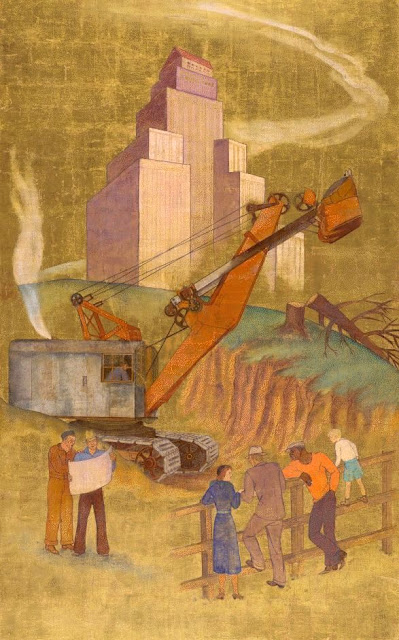Above: The description for this photograph, taken in Rocky River, Ohio, ca. 1935-1943, reads, "New cabin in the Girl Scouts Reservation - Much of the lumber in this building came from an old frame house demolished by the WPA." Photo courtesy of the National Archives.
Above: An information pavilion in Washington, DC, set up by the New Deal's National Youth Administration and the Boy Scouts of America, ca. 1935-1943. Photo courtesy of the National Archives.
Above: The description for this photograph, taken near Findlay, Ohio, ca. 1935-1943, reads, "Enhanced by $50,000 worth of improvements by WPA workers, the Berry Boy Scout Reservation... has become the outstanding camping place for boys and girls in this section of the state. The reservation covers 80 acres. Tent floors and the hundreds of trees are some of the improvements made by the unemployed men on the WPA projects. Five frame buildings were also built by WPA." Today, on the Camp Berry web page, it states: "a swimming pool and shower house were built by the WPA in 1937. A headquarters cabin and three overnight cabins were also built at this time." Photo courtesy of the National Archives.
Above: This photo shows WPA workers in Portsmouth, Ohio, ca. 1935-1943, "putting in base logs of a cabin that will be used by local boy scouts as their meeting place and recreational center." Photo courtesy of the National Archives.
Above: A WPA-supported archery class for a Camp Fire Girls of America camp in Pennsylvania, ca. 1935-1943. Today, the organization is just called "Camp Fire," and is open to both girls and boys. Photo courtesy of the National Archives.
Above: A WPA-built club house for the Boys & Girls Club of Vernon, Texas, 1937. The Boys & Girls Club of Vernon still operates today, and offers after-school programs for K-12 youth, related to "character & leadership, education & career, health & life, the arts, and sports & activities," but it's unclear whether the WPA-built club house still exists. Photo courtesy of the National Archives.
Above: WPA workers built this 4-H club house in Cabell County, West Virginia (near Huntington), ca. 1935-1943. According to their website, "4‑H is delivered by Cooperative Extension - a community of more than 100 public universities across the nation that provides experiences where young people learn by doing. Kids complete hands-on projects in areas like health, science, agriculture and citizenship, in a positive environment where they receive guidance from adult mentors and are encouraged to take on proactive leadership roles." Photo courtesy of the National Archives.
Above: The WPA-built club house, still used by 4-H today (see previous photo). Photo courtesy of the Cabell County Commission, used here for educational, non-commercial purposes.
Above: In addition to helping existing youth organizations, the New Deal created plenty of it own projects too, like this National Youth Administration (NYA) summer camp for disadvantaged kids, in Chepachet, Rhode Island, ca. 1935-1943. Photo courtesy of the National Archives.
Above: These young women are youth leaders at the NYA summer camp in Chepachet, Rhode Island. Many young adults trained to be camp and recreation leaders, while also earning a paycheck, in the NYA. Photo courtesy of the National Archives.
Above: An information pavilion in Washington, DC, set up by the New Deal's National Youth Administration and the Boy Scouts of America, ca. 1935-1943. Photo courtesy of the National Archives.
Above: The description for this photograph, taken near Findlay, Ohio, ca. 1935-1943, reads, "Enhanced by $50,000 worth of improvements by WPA workers, the Berry Boy Scout Reservation... has become the outstanding camping place for boys and girls in this section of the state. The reservation covers 80 acres. Tent floors and the hundreds of trees are some of the improvements made by the unemployed men on the WPA projects. Five frame buildings were also built by WPA." Today, on the Camp Berry web page, it states: "a swimming pool and shower house were built by the WPA in 1937. A headquarters cabin and three overnight cabins were also built at this time." Photo courtesy of the National Archives.
Above: This photo shows WPA workers in Portsmouth, Ohio, ca. 1935-1943, "putting in base logs of a cabin that will be used by local boy scouts as their meeting place and recreational center." Photo courtesy of the National Archives.
Above: A WPA-supported archery class for a Camp Fire Girls of America camp in Pennsylvania, ca. 1935-1943. Today, the organization is just called "Camp Fire," and is open to both girls and boys. Photo courtesy of the National Archives.
Above: A WPA-built club house for the Boys & Girls Club of Vernon, Texas, 1937. The Boys & Girls Club of Vernon still operates today, and offers after-school programs for K-12 youth, related to "character & leadership, education & career, health & life, the arts, and sports & activities," but it's unclear whether the WPA-built club house still exists. Photo courtesy of the National Archives.
Above: The WPA-built club house, still used by 4-H today (see previous photo). Photo courtesy of the Cabell County Commission, used here for educational, non-commercial purposes.
Above: In addition to helping existing youth organizations, the New Deal created plenty of it own projects too, like this National Youth Administration (NYA) summer camp for disadvantaged kids, in Chepachet, Rhode Island, ca. 1935-1943. Photo courtesy of the National Archives.
Above: These young women are youth leaders at the NYA summer camp in Chepachet, Rhode Island. Many young adults trained to be camp and recreation leaders, while also earning a paycheck, in the NYA. Photo courtesy of the National Archives.


























